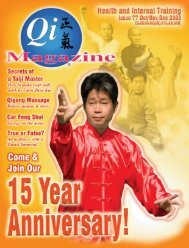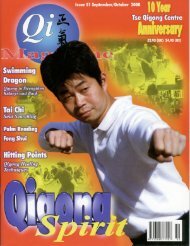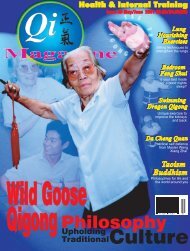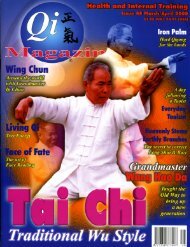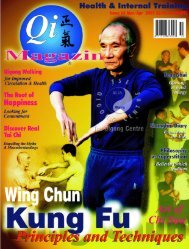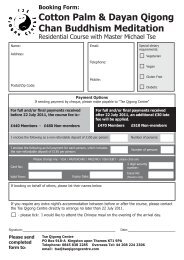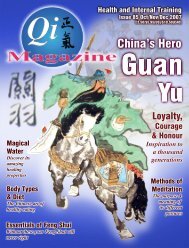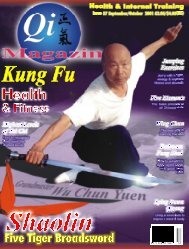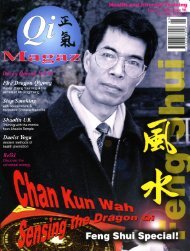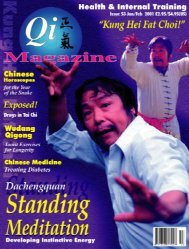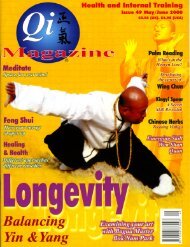You also want an ePaper? Increase the reach of your titles
YUMPU automatically turns print PDFs into web optimized ePapers that Google loves.
The riddle of the Sphynx asks, “What walks on four legs in the<br />
morning, two legs in the afternoon and three legs in the evening?”<br />
The Art of Balance<br />
The answer is…mankind. In the<br />
morning of our lives, when we are<br />
young, we crawl on four legs. In the<br />
afternoon, in the prime of our lives, we<br />
walk tall on two legs. And in the evening,<br />
when we have lost the strength of our<br />
youth, we walk on three legs - two legs<br />
of our own and a stick to support our<br />
failing posture when we’ve lost the<br />
strength to hold ourselves up.<br />
Walking on four legs (crawling) is<br />
not an instant means of mobility. It is a<br />
progression that first requires us to have<br />
obtained enough strength to lift our<br />
bodies off the ground, as I have<br />
observed in my niece. First, she tried to<br />
lift her body off of the floor but her<br />
arms were not strong enough.<br />
Then, little by little, she<br />
managed to lift herself up<br />
though not with much control<br />
because most of the times<br />
that she managed to push,<br />
she pushed too hard and<br />
pushed herself over onto<br />
her back. There she lay like<br />
an overturned turtle until<br />
with a little roll she would<br />
get back onto her chest.<br />
Eventually, she<br />
developed enough<br />
strength to lift her body<br />
weight and the next time I<br />
went round to see my<br />
brother, she had gathered the<br />
co-ordination and balance to<br />
boldly go where she wanted, or<br />
wasn’t supposed to go, as there were<br />
little gates all around to see she didn’t.<br />
From four legs the next step in<br />
evolution is to rise onto two legs. Again,<br />
I observed my niece as she attempted<br />
to walk upright. The main struggle this<br />
time seemed to be the balance. She had<br />
the strength to pull herself skywards but<br />
when she got there and let go of what<br />
was supporting her, it all looked a little<br />
precarious and would usually end with<br />
her falling back onto her behind. With<br />
determination she would pick herself up<br />
and start all over again, until eventually<br />
she had enough balance to take some<br />
steps with the aid of the arms and legs<br />
of furniture.<br />
The hardest thing to grasp when<br />
moving from four legs onto two legs<br />
would seem to be the balance. You can<br />
have the strength to get up, but to keep<br />
yourself upright and then lift one foot<br />
off the ground and step requires balance.<br />
But where does balance come from and<br />
how is it created?<br />
For most people, balance is<br />
created by using strength and tension to<br />
hold themselves upright. This is fine but<br />
will not necessarily mean that they have<br />
a good posture and this will, in turn,<br />
hamper their flexibility and mobility and<br />
cause them to use up their energy ( Qi ).<br />
This might be okay whilst you are<br />
y o u n g<br />
a n d<br />
have plenty of energy to spare. It is like<br />
a structure made of simple wooden<br />
building blocks. If they are placed on top<br />
of each other, edge to edge and all the<br />
faces in line, then the structure will be<br />
able to rise and remain stable as it<br />
increases in height because all the<br />
weight is passing down in a straight line<br />
in one direction to the base. But if this is<br />
not the case and the blocks are crooked<br />
and out-of-line, the structure will still rise<br />
though the weight of it will no longer be<br />
travelling in a straight line to the base.<br />
This will eventually cause adverse<br />
pressure, fatigue and weakness to the<br />
structure.<br />
For my own experience,<br />
before I started <strong>Qigong</strong> my<br />
structure or posture was like<br />
that of out-of-kilter blocks. It<br />
was twisted and stiff and took<br />
a lot of strength to hold it all together. In<br />
fact, I used so much strength to keep my<br />
balance that it made me weak and<br />
unstable as my energy was carried in my<br />
shoulders and chest. If I bumped into<br />
anything or anything bumped into me, I<br />
would be knocked off my feet and would<br />
have to struggle to recover.<br />
My balance and posture had<br />
become like that due to a brain tumour<br />
I had when I was eleven years old. Even<br />
before the tumour was operated on<br />
it had been affecting my balance<br />
and vision, and after it was dealt<br />
with through surgery and<br />
radio-therapy, it left me with<br />
a visual impairment and a<br />
missing sense of balance.<br />
My body tried to<br />
cope the best it could but<br />
it did so by clamming up<br />
to protect and keep itself<br />
together. My lack of<br />
eyesight (I only have a very<br />
limited amount of vision in<br />
my right eye) meant I had<br />
to peer down at the<br />
ground to see where I was<br />
going and often had to twist<br />
my neck and body to use what<br />
vision was still left.<br />
This all affected my posture<br />
and put more pressure on my weak<br />
sense of balance. I bungled along like<br />
this for seventeen years with an everdecreasing<br />
quality of posture causing<br />
ever-increased levels of inflexibility,<br />
tension and stiffness.. All this required<br />
more strength and energy. It was a<br />
vicious circle that was drawing me closer<br />
to walking on three legs and was creating<br />
numbness and tingling in my hands neck<br />
and face.<br />
Then I managed to bump into<br />
something that really knocked me over,<br />
but then picked me up and helped me<br />
on my way. This was <strong>Qigong</strong>. It picked<br />
me up and put me back together or<br />
should I say it taught me to put myself<br />
back together?<br />
by Martin Gale.<br />
martin@qimagazine.com<br />
page 48 Qi Magazine Apr/May/June 2007



